Understanding Vaccine Hesitancy: Causes, Consequences, and Solutions
VerifiedAdded on 2023/04/23
|7
|1792
|67
Report
AI Summary
This report provides a comprehensive overview of vaccine hesitancy, exploring its causes and consequences. Vaccine hesitancy, defined as the delay in acceptance or refusal of vaccines despite their availability, poses a significant threat to public health. The report reviews research articles identifying factors contributing to vaccine hesitancy, including concerns about vaccine safety, mistrust in healthcare providers, and misinformation. The adverse effects of vaccines and the nature of their ingredients also play a role in parental decisions regarding vaccination. The consequences of vaccine hesitancy include increased rates of vaccine-preventable diseases and reduced community immunity. The report concludes by emphasizing the importance of addressing vaccine hesitancy through education and trust-building to promote public health.
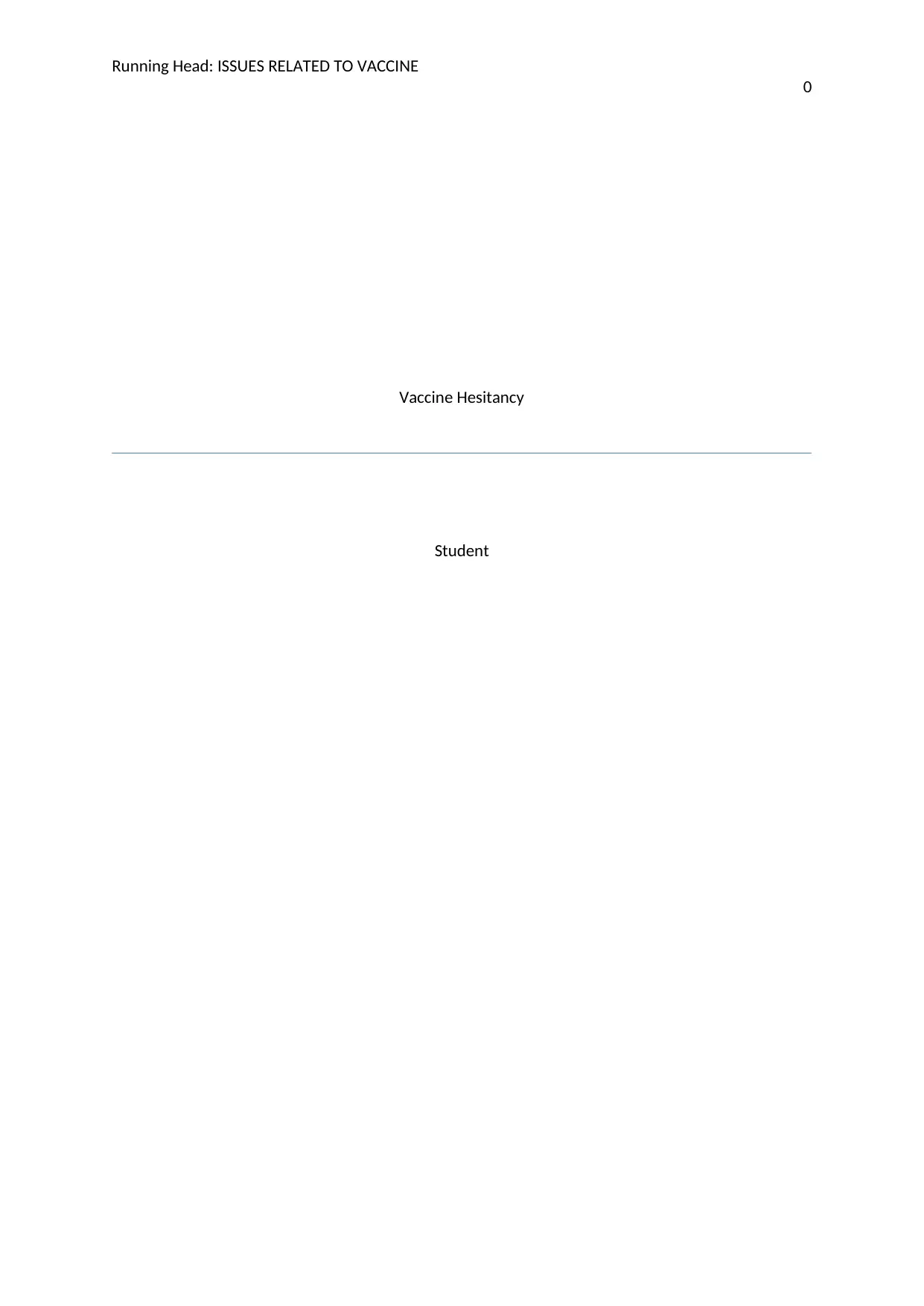
Running Head: ISSUES RELATED TO VACCINE
0
Vaccine Hesitancy
Student
0
Vaccine Hesitancy
Student
Paraphrase This Document
Need a fresh take? Get an instant paraphrase of this document with our AI Paraphraser
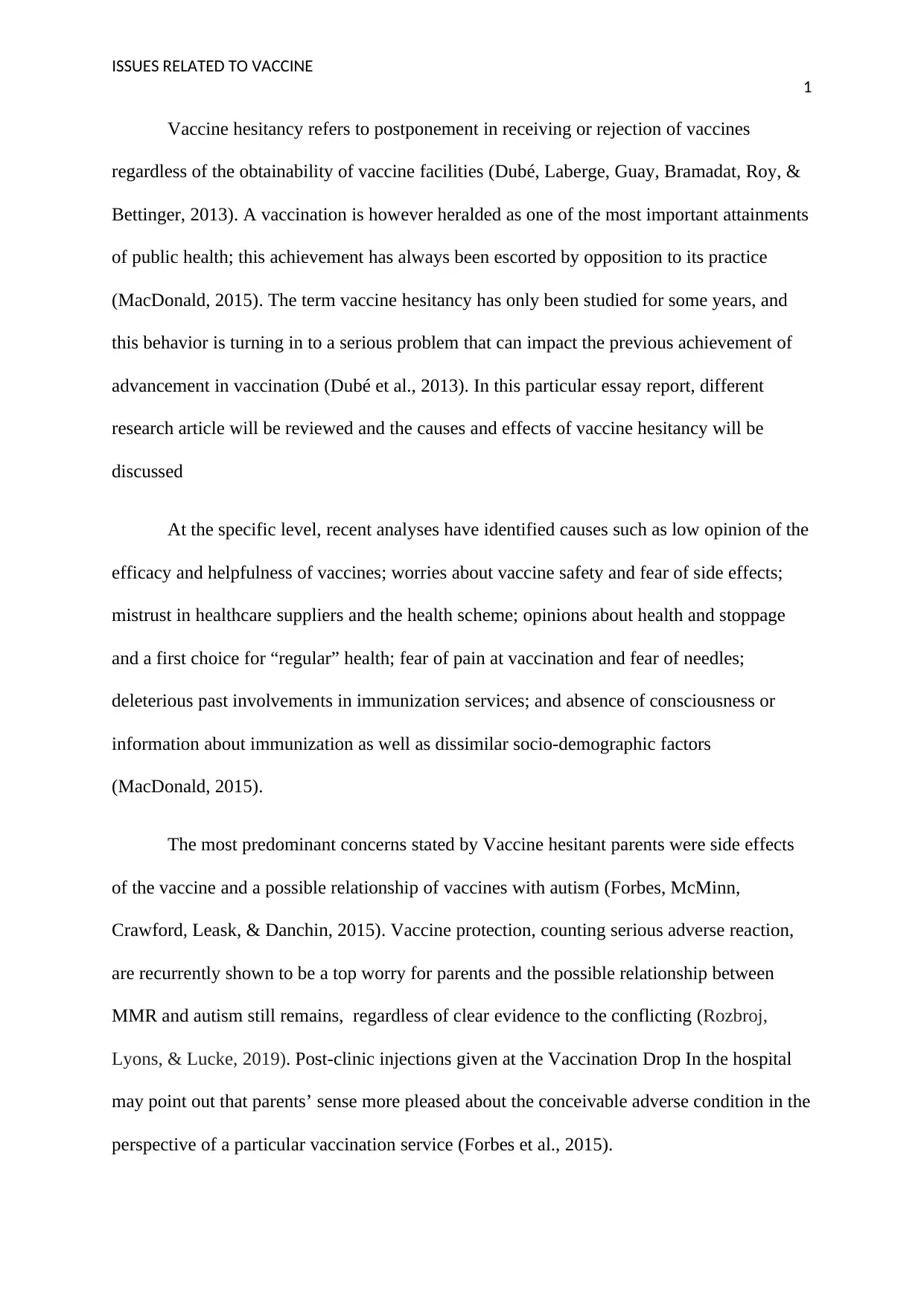
ISSUES RELATED TO VACCINE
1
Vaccine hesitancy refers to postponement in receiving or rejection of vaccines
regardless of the obtainability of vaccine facilities (Dubé, Laberge, Guay, Bramadat, Roy, &
Bettinger, 2013). A vaccination is however heralded as one of the most important attainments
of public health; this achievement has always been escorted by opposition to its practice
(MacDonald, 2015). The term vaccine hesitancy has only been studied for some years, and
this behavior is turning in to a serious problem that can impact the previous achievement of
advancement in vaccination (Dubé et al., 2013). In this particular essay report, different
research article will be reviewed and the causes and effects of vaccine hesitancy will be
discussed
At the specific level, recent analyses have identified causes such as low opinion of the
efficacy and helpfulness of vaccines; worries about vaccine safety and fear of side effects;
mistrust in healthcare suppliers and the health scheme; opinions about health and stoppage
and a first choice for “regular” health; fear of pain at vaccination and fear of needles;
deleterious past involvements in immunization services; and absence of consciousness or
information about immunization as well as dissimilar socio-demographic factors
(MacDonald, 2015).
The most predominant concerns stated by Vaccine hesitant parents were side effects
of the vaccine and a possible relationship of vaccines with autism (Forbes, McMinn,
Crawford, Leask, & Danchin, 2015). Vaccine protection, counting serious adverse reaction,
are recurrently shown to be a top worry for parents and the possible relationship between
MMR and autism still remains, regardless of clear evidence to the conflicting (Rozbroj,
Lyons, & Lucke, 2019). Post-clinic injections given at the Vaccination Drop In the hospital
may point out that parents’ sense more pleased about the conceivable adverse condition in the
perspective of a particular vaccination service (Forbes et al., 2015).
1
Vaccine hesitancy refers to postponement in receiving or rejection of vaccines
regardless of the obtainability of vaccine facilities (Dubé, Laberge, Guay, Bramadat, Roy, &
Bettinger, 2013). A vaccination is however heralded as one of the most important attainments
of public health; this achievement has always been escorted by opposition to its practice
(MacDonald, 2015). The term vaccine hesitancy has only been studied for some years, and
this behavior is turning in to a serious problem that can impact the previous achievement of
advancement in vaccination (Dubé et al., 2013). In this particular essay report, different
research article will be reviewed and the causes and effects of vaccine hesitancy will be
discussed
At the specific level, recent analyses have identified causes such as low opinion of the
efficacy and helpfulness of vaccines; worries about vaccine safety and fear of side effects;
mistrust in healthcare suppliers and the health scheme; opinions about health and stoppage
and a first choice for “regular” health; fear of pain at vaccination and fear of needles;
deleterious past involvements in immunization services; and absence of consciousness or
information about immunization as well as dissimilar socio-demographic factors
(MacDonald, 2015).
The most predominant concerns stated by Vaccine hesitant parents were side effects
of the vaccine and a possible relationship of vaccines with autism (Forbes, McMinn,
Crawford, Leask, & Danchin, 2015). Vaccine protection, counting serious adverse reaction,
are recurrently shown to be a top worry for parents and the possible relationship between
MMR and autism still remains, regardless of clear evidence to the conflicting (Rozbroj,
Lyons, & Lucke, 2019). Post-clinic injections given at the Vaccination Drop In the hospital
may point out that parents’ sense more pleased about the conceivable adverse condition in the
perspective of a particular vaccination service (Forbes et al., 2015).
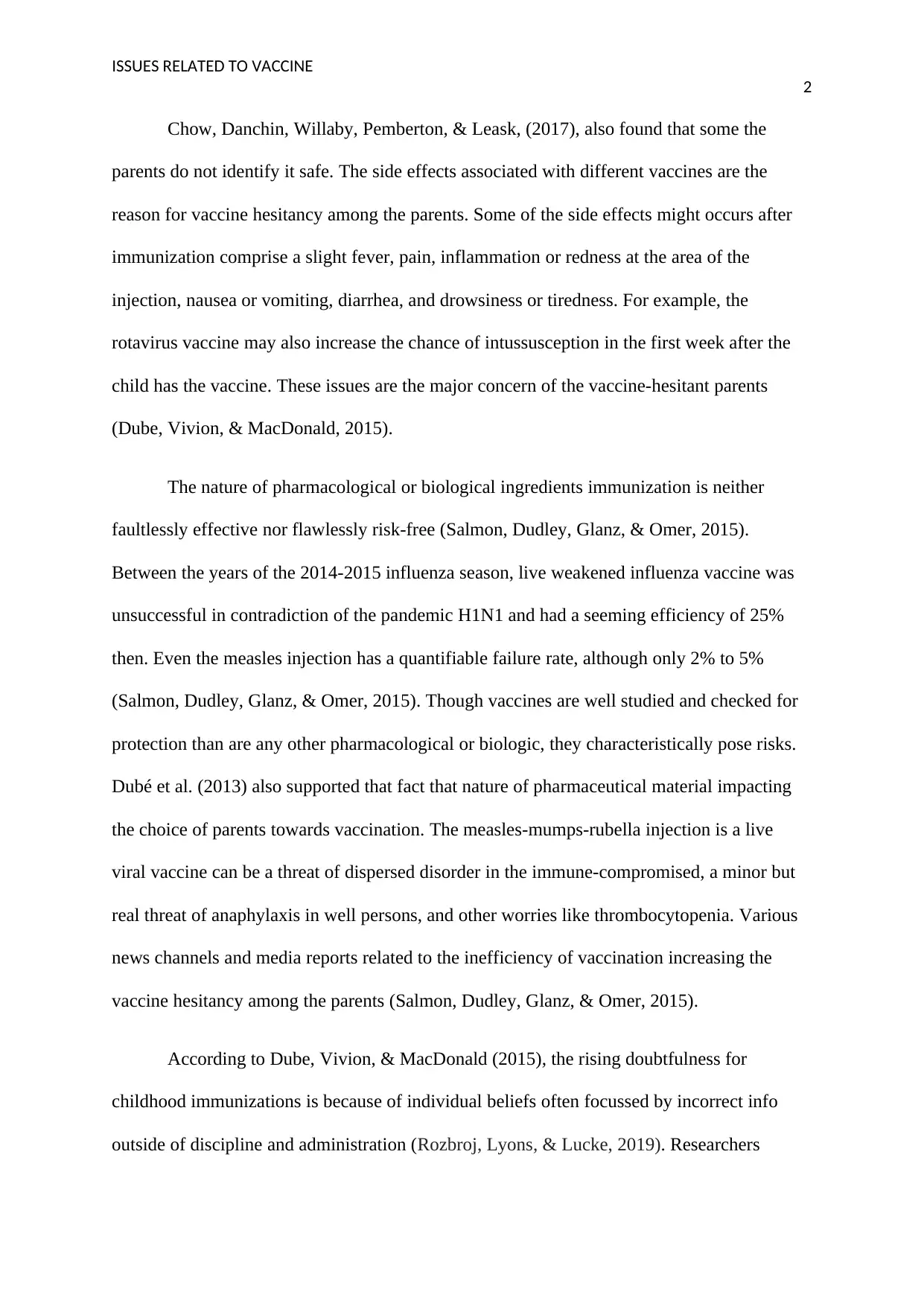
ISSUES RELATED TO VACCINE
2
Chow, Danchin, Willaby, Pemberton, & Leask, (2017), also found that some the
parents do not identify it safe. The side effects associated with different vaccines are the
reason for vaccine hesitancy among the parents. Some of the side effects might occurs after
immunization comprise a slight fever, pain, inflammation or redness at the area of the
injection, nausea or vomiting, diarrhea, and drowsiness or tiredness. For example, the
rotavirus vaccine may also increase the chance of intussusception in the first week after the
child has the vaccine. These issues are the major concern of the vaccine-hesitant parents
(Dube, Vivion, & MacDonald, 2015).
The nature of pharmacological or biological ingredients immunization is neither
faultlessly effective nor flawlessly risk-free (Salmon, Dudley, Glanz, & Omer, 2015).
Between the years of the 2014-2015 influenza season, live weakened influenza vaccine was
unsuccessful in contradiction of the pandemic H1N1 and had a seeming efficiency of 25%
then. Even the measles injection has a quantifiable failure rate, although only 2% to 5%
(Salmon, Dudley, Glanz, & Omer, 2015). Though vaccines are well studied and checked for
protection than are any other pharmacological or biologic, they characteristically pose risks.
Dubé et al. (2013) also supported that fact that nature of pharmaceutical material impacting
the choice of parents towards vaccination. The measles-mumps-rubella injection is a live
viral vaccine can be a threat of dispersed disorder in the immune-compromised, a minor but
real threat of anaphylaxis in well persons, and other worries like thrombocytopenia. Various
news channels and media reports related to the inefficiency of vaccination increasing the
vaccine hesitancy among the parents (Salmon, Dudley, Glanz, & Omer, 2015).
According to Dube, Vivion, & MacDonald (2015), the rising doubtfulness for
childhood immunizations is because of individual beliefs often focussed by incorrect info
outside of discipline and administration (Rozbroj, Lyons, & Lucke, 2019). Researchers
2
Chow, Danchin, Willaby, Pemberton, & Leask, (2017), also found that some the
parents do not identify it safe. The side effects associated with different vaccines are the
reason for vaccine hesitancy among the parents. Some of the side effects might occurs after
immunization comprise a slight fever, pain, inflammation or redness at the area of the
injection, nausea or vomiting, diarrhea, and drowsiness or tiredness. For example, the
rotavirus vaccine may also increase the chance of intussusception in the first week after the
child has the vaccine. These issues are the major concern of the vaccine-hesitant parents
(Dube, Vivion, & MacDonald, 2015).
The nature of pharmacological or biological ingredients immunization is neither
faultlessly effective nor flawlessly risk-free (Salmon, Dudley, Glanz, & Omer, 2015).
Between the years of the 2014-2015 influenza season, live weakened influenza vaccine was
unsuccessful in contradiction of the pandemic H1N1 and had a seeming efficiency of 25%
then. Even the measles injection has a quantifiable failure rate, although only 2% to 5%
(Salmon, Dudley, Glanz, & Omer, 2015). Though vaccines are well studied and checked for
protection than are any other pharmacological or biologic, they characteristically pose risks.
Dubé et al. (2013) also supported that fact that nature of pharmaceutical material impacting
the choice of parents towards vaccination. The measles-mumps-rubella injection is a live
viral vaccine can be a threat of dispersed disorder in the immune-compromised, a minor but
real threat of anaphylaxis in well persons, and other worries like thrombocytopenia. Various
news channels and media reports related to the inefficiency of vaccination increasing the
vaccine hesitancy among the parents (Salmon, Dudley, Glanz, & Omer, 2015).
According to Dube, Vivion, & MacDonald (2015), the rising doubtfulness for
childhood immunizations is because of individual beliefs often focussed by incorrect info
outside of discipline and administration (Rozbroj, Lyons, & Lucke, 2019). Researchers
⊘ This is a preview!⊘
Do you want full access?
Subscribe today to unlock all pages.

Trusted by 1+ million students worldwide
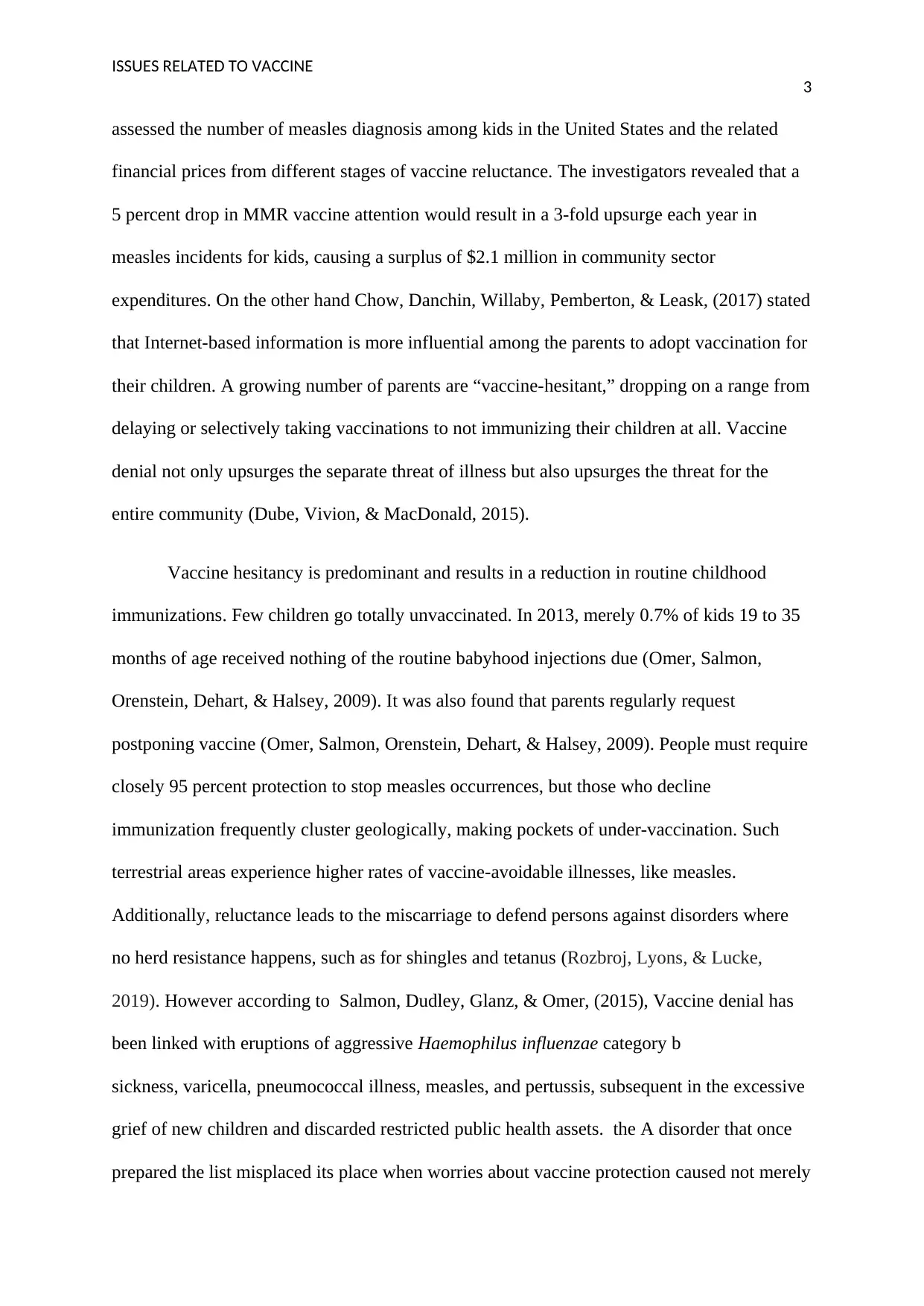
ISSUES RELATED TO VACCINE
3
assessed the number of measles diagnosis among kids in the United States and the related
financial prices from different stages of vaccine reluctance. The investigators revealed that a
5 percent drop in MMR vaccine attention would result in a 3-fold upsurge each year in
measles incidents for kids, causing a surplus of $2.1 million in community sector
expenditures. On the other hand Chow, Danchin, Willaby, Pemberton, & Leask, (2017) stated
that Internet-based information is more influential among the parents to adopt vaccination for
their children. A growing number of parents are “vaccine-hesitant,” dropping on a range from
delaying or selectively taking vaccinations to not immunizing their children at all. Vaccine
denial not only upsurges the separate threat of illness but also upsurges the threat for the
entire community (Dube, Vivion, & MacDonald, 2015).
Vaccine hesitancy is predominant and results in a reduction in routine childhood
immunizations. Few children go totally unvaccinated. In 2013, merely 0.7% of kids 19 to 35
months of age received nothing of the routine babyhood injections due (Omer, Salmon,
Orenstein, Dehart, & Halsey, 2009). It was also found that parents regularly request
postponing vaccine (Omer, Salmon, Orenstein, Dehart, & Halsey, 2009). People must require
closely 95 percent protection to stop measles occurrences, but those who decline
immunization frequently cluster geologically, making pockets of under-vaccination. Such
terrestrial areas experience higher rates of vaccine-avoidable illnesses, like measles.
Additionally, reluctance leads to the miscarriage to defend persons against disorders where
no herd resistance happens, such as for shingles and tetanus (Rozbroj, Lyons, & Lucke,
2019). However according to Salmon, Dudley, Glanz, & Omer, (2015), Vaccine denial has
been linked with eruptions of aggressive Haemophilus influenzae category b
sickness, varicella, pneumococcal illness, measles, and pertussis, subsequent in the excessive
grief of new children and discarded restricted public health assets. the A disorder that once
prepared the list misplaced its place when worries about vaccine protection caused not merely
3
assessed the number of measles diagnosis among kids in the United States and the related
financial prices from different stages of vaccine reluctance. The investigators revealed that a
5 percent drop in MMR vaccine attention would result in a 3-fold upsurge each year in
measles incidents for kids, causing a surplus of $2.1 million in community sector
expenditures. On the other hand Chow, Danchin, Willaby, Pemberton, & Leask, (2017) stated
that Internet-based information is more influential among the parents to adopt vaccination for
their children. A growing number of parents are “vaccine-hesitant,” dropping on a range from
delaying or selectively taking vaccinations to not immunizing their children at all. Vaccine
denial not only upsurges the separate threat of illness but also upsurges the threat for the
entire community (Dube, Vivion, & MacDonald, 2015).
Vaccine hesitancy is predominant and results in a reduction in routine childhood
immunizations. Few children go totally unvaccinated. In 2013, merely 0.7% of kids 19 to 35
months of age received nothing of the routine babyhood injections due (Omer, Salmon,
Orenstein, Dehart, & Halsey, 2009). It was also found that parents regularly request
postponing vaccine (Omer, Salmon, Orenstein, Dehart, & Halsey, 2009). People must require
closely 95 percent protection to stop measles occurrences, but those who decline
immunization frequently cluster geologically, making pockets of under-vaccination. Such
terrestrial areas experience higher rates of vaccine-avoidable illnesses, like measles.
Additionally, reluctance leads to the miscarriage to defend persons against disorders where
no herd resistance happens, such as for shingles and tetanus (Rozbroj, Lyons, & Lucke,
2019). However according to Salmon, Dudley, Glanz, & Omer, (2015), Vaccine denial has
been linked with eruptions of aggressive Haemophilus influenzae category b
sickness, varicella, pneumococcal illness, measles, and pertussis, subsequent in the excessive
grief of new children and discarded restricted public health assets. the A disorder that once
prepared the list misplaced its place when worries about vaccine protection caused not merely
Paraphrase This Document
Need a fresh take? Get an instant paraphrase of this document with our AI Paraphraser
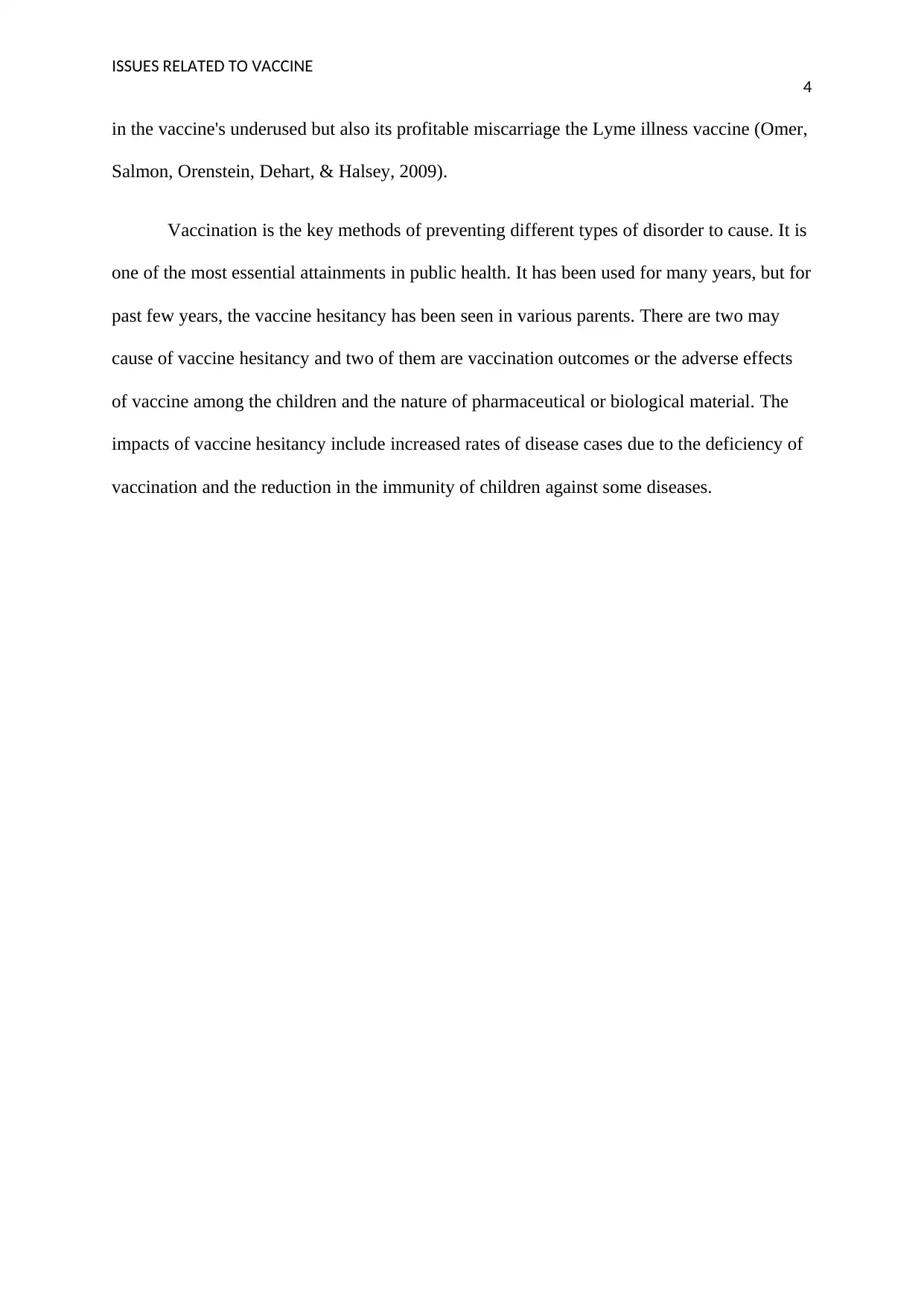
ISSUES RELATED TO VACCINE
4
in the vaccine's underused but also its profitable miscarriage the Lyme illness vaccine (Omer,
Salmon, Orenstein, Dehart, & Halsey, 2009).
Vaccination is the key methods of preventing different types of disorder to cause. It is
one of the most essential attainments in public health. It has been used for many years, but for
past few years, the vaccine hesitancy has been seen in various parents. There are two may
cause of vaccine hesitancy and two of them are vaccination outcomes or the adverse effects
of vaccine among the children and the nature of pharmaceutical or biological material. The
impacts of vaccine hesitancy include increased rates of disease cases due to the deficiency of
vaccination and the reduction in the immunity of children against some diseases.
4
in the vaccine's underused but also its profitable miscarriage the Lyme illness vaccine (Omer,
Salmon, Orenstein, Dehart, & Halsey, 2009).
Vaccination is the key methods of preventing different types of disorder to cause. It is
one of the most essential attainments in public health. It has been used for many years, but for
past few years, the vaccine hesitancy has been seen in various parents. There are two may
cause of vaccine hesitancy and two of them are vaccination outcomes or the adverse effects
of vaccine among the children and the nature of pharmaceutical or biological material. The
impacts of vaccine hesitancy include increased rates of disease cases due to the deficiency of
vaccination and the reduction in the immunity of children against some diseases.
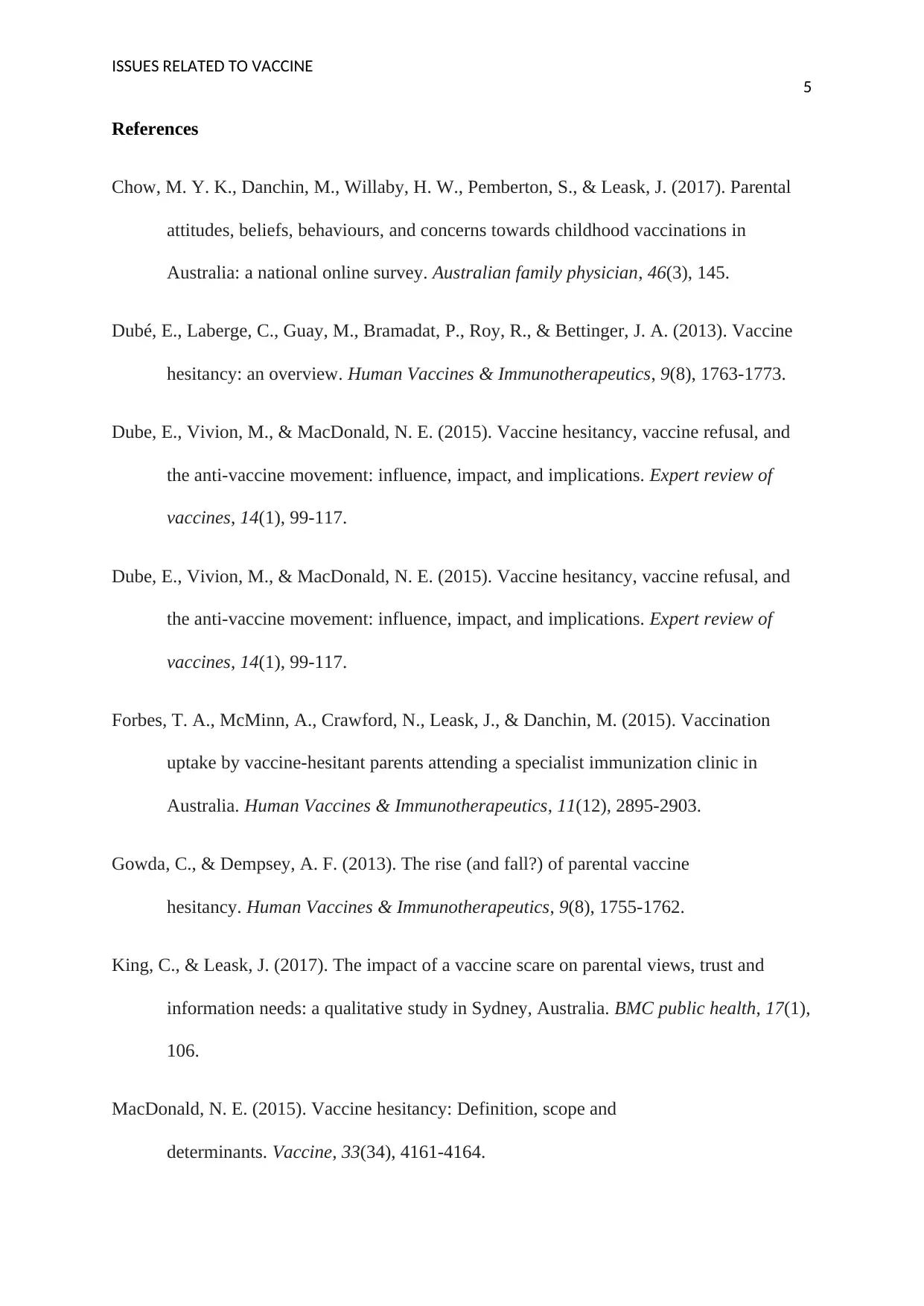
ISSUES RELATED TO VACCINE
5
References
Chow, M. Y. K., Danchin, M., Willaby, H. W., Pemberton, S., & Leask, J. (2017). Parental
attitudes, beliefs, behaviours, and concerns towards childhood vaccinations in
Australia: a national online survey. Australian family physician, 46(3), 145.
Dubé, E., Laberge, C., Guay, M., Bramadat, P., Roy, R., & Bettinger, J. A. (2013). Vaccine
hesitancy: an overview. Human Vaccines & Immunotherapeutics, 9(8), 1763-1773.
Dube, E., Vivion, M., & MacDonald, N. E. (2015). Vaccine hesitancy, vaccine refusal, and
the anti-vaccine movement: influence, impact, and implications. Expert review of
vaccines, 14(1), 99-117.
Dube, E., Vivion, M., & MacDonald, N. E. (2015). Vaccine hesitancy, vaccine refusal, and
the anti-vaccine movement: influence, impact, and implications. Expert review of
vaccines, 14(1), 99-117.
Forbes, T. A., McMinn, A., Crawford, N., Leask, J., & Danchin, M. (2015). Vaccination
uptake by vaccine-hesitant parents attending a specialist immunization clinic in
Australia. Human Vaccines & Immunotherapeutics, 11(12), 2895-2903.
Gowda, C., & Dempsey, A. F. (2013). The rise (and fall?) of parental vaccine
hesitancy. Human Vaccines & Immunotherapeutics, 9(8), 1755-1762.
King, C., & Leask, J. (2017). The impact of a vaccine scare on parental views, trust and
information needs: a qualitative study in Sydney, Australia. BMC public health, 17(1),
106.
MacDonald, N. E. (2015). Vaccine hesitancy: Definition, scope and
determinants. Vaccine, 33(34), 4161-4164.
5
References
Chow, M. Y. K., Danchin, M., Willaby, H. W., Pemberton, S., & Leask, J. (2017). Parental
attitudes, beliefs, behaviours, and concerns towards childhood vaccinations in
Australia: a national online survey. Australian family physician, 46(3), 145.
Dubé, E., Laberge, C., Guay, M., Bramadat, P., Roy, R., & Bettinger, J. A. (2013). Vaccine
hesitancy: an overview. Human Vaccines & Immunotherapeutics, 9(8), 1763-1773.
Dube, E., Vivion, M., & MacDonald, N. E. (2015). Vaccine hesitancy, vaccine refusal, and
the anti-vaccine movement: influence, impact, and implications. Expert review of
vaccines, 14(1), 99-117.
Dube, E., Vivion, M., & MacDonald, N. E. (2015). Vaccine hesitancy, vaccine refusal, and
the anti-vaccine movement: influence, impact, and implications. Expert review of
vaccines, 14(1), 99-117.
Forbes, T. A., McMinn, A., Crawford, N., Leask, J., & Danchin, M. (2015). Vaccination
uptake by vaccine-hesitant parents attending a specialist immunization clinic in
Australia. Human Vaccines & Immunotherapeutics, 11(12), 2895-2903.
Gowda, C., & Dempsey, A. F. (2013). The rise (and fall?) of parental vaccine
hesitancy. Human Vaccines & Immunotherapeutics, 9(8), 1755-1762.
King, C., & Leask, J. (2017). The impact of a vaccine scare on parental views, trust and
information needs: a qualitative study in Sydney, Australia. BMC public health, 17(1),
106.
MacDonald, N. E. (2015). Vaccine hesitancy: Definition, scope and
determinants. Vaccine, 33(34), 4161-4164.
⊘ This is a preview!⊘
Do you want full access?
Subscribe today to unlock all pages.

Trusted by 1+ million students worldwide
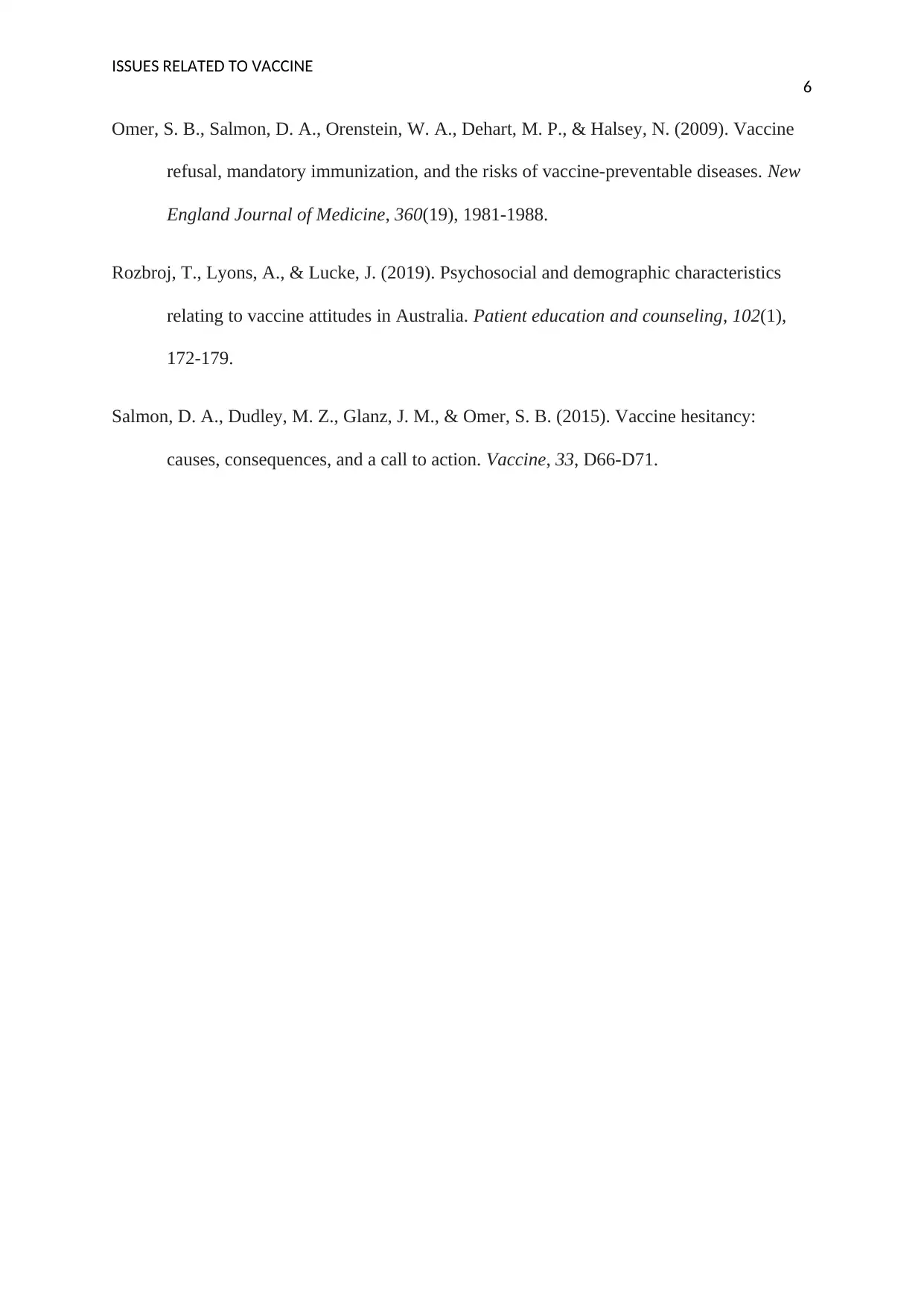
ISSUES RELATED TO VACCINE
6
Omer, S. B., Salmon, D. A., Orenstein, W. A., Dehart, M. P., & Halsey, N. (2009). Vaccine
refusal, mandatory immunization, and the risks of vaccine-preventable diseases. New
England Journal of Medicine, 360(19), 1981-1988.
Rozbroj, T., Lyons, A., & Lucke, J. (2019). Psychosocial and demographic characteristics
relating to vaccine attitudes in Australia. Patient education and counseling, 102(1),
172-179.
Salmon, D. A., Dudley, M. Z., Glanz, J. M., & Omer, S. B. (2015). Vaccine hesitancy:
causes, consequences, and a call to action. Vaccine, 33, D66-D71.
6
Omer, S. B., Salmon, D. A., Orenstein, W. A., Dehart, M. P., & Halsey, N. (2009). Vaccine
refusal, mandatory immunization, and the risks of vaccine-preventable diseases. New
England Journal of Medicine, 360(19), 1981-1988.
Rozbroj, T., Lyons, A., & Lucke, J. (2019). Psychosocial and demographic characteristics
relating to vaccine attitudes in Australia. Patient education and counseling, 102(1),
172-179.
Salmon, D. A., Dudley, M. Z., Glanz, J. M., & Omer, S. B. (2015). Vaccine hesitancy:
causes, consequences, and a call to action. Vaccine, 33, D66-D71.
1 out of 7
Your All-in-One AI-Powered Toolkit for Academic Success.
+13062052269
info@desklib.com
Available 24*7 on WhatsApp / Email
![[object Object]](/_next/static/media/star-bottom.7253800d.svg)
Unlock your academic potential
Copyright © 2020–2025 A2Z Services. All Rights Reserved. Developed and managed by ZUCOL.